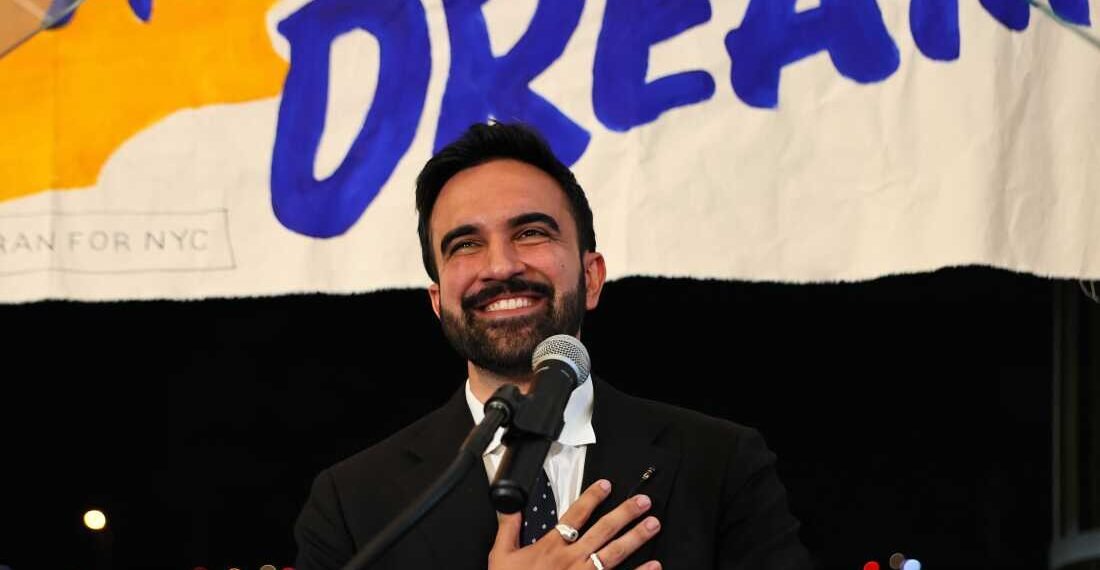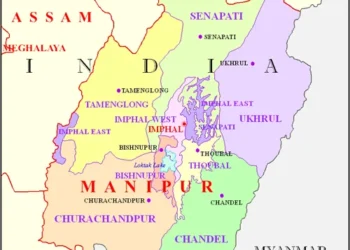Mamdani’s victory signals a generational revolt against establishment politics, with a bold platform promising rent freezes, fare-free public transport, universal childcare, and a $30 minimum wage — a sharp contrast to Trump’s capitalist creed.
BY PC Bureau
November 5, 2025: In one of the most consequential municipal elections in recent American history, Zohran Kwame Mamdani, a 34-year-old democratic socialist and New York State Assemblymember, has been elected Mayor of New York City, shattering records, barriers, and political assumptions alike. His landslide victory marks a generational and ideological earthquake — from Wall Street’s corridors to the White House — signaling that America’s largest city has chosen a radical new course.
By defeating former Governor Andrew Cuomo in a bruising Democratic primary and then routing Republican Curtis Sliwa in the general election, Mamdani has set the stage for the most left-wing administration in New York’s modern history. With 98% of precincts reporting, he captured 58% of the vote, compared to Sliwa’s 28% and Cuomo’s 9% write-in tally. Over 2.1 million ballots were cast — the highest turnout since John Lindsay’s 1969 victory — underscoring the depth of New Yorkers’ hunger for change.
“This is a mandate for transformation,” Mamdani declared in his victory address before tens of thousands gathered in Brooklyn’s Prospect Park, flanked by allies Rep. Alexandria Ocasio-Cortez and Sen. Bernie Sanders. “New Yorkers have said yes to a city that works for the many — not the moneyed few.”
For Donald Trump, who will begin his second presidential term on January 20, 2025, the result is far more than a local upset. It is a personal and ideological repudiation — a rejection of the city’s most famous son by the metropolis he once claimed as his empire.
Americans are finally waking up to the lies they were sold by Trump — and they’re beginning to stand up against it.
Mamdani’s policies and rhetoric are the antithesis of capitalism and everything this country stands for. This wasn’t an election driven by principle or progress —… pic.twitter.com/VNsZYCaPQb
— SaraLee (@SarAEsQMd) November 5, 2025
From Kampala to City Hall: The Rise of a Revolutionary
Born in Kampala, Uganda, in 1991, to renowned scholar Mahmood Mamdani and Oscar-nominated filmmaker Mira Nair, Zohran Mamdani immigrated to New York at age seven. His upbringing — from Queens public housing to the Bronx High School of Science, and later Bowdoin College, where he earned a degree in Africana Studies — shaped his political consciousness.
As a student, Mamdani organized for labor rights and racial justice, co-founding a campus chapter of Students for Justice in Palestine. When elected to the New York State Assembly in 2020 at age 29, he quickly became the face of the city’s new socialist movement, introducing legislation on rent stabilization, public banking, and police reform.
Dismissed by pundits as a long-shot when he launched his mayoral campaign in February 2025, Mamdani built a grassroots machine powered by small donors (averaging $18 per contribution), door-to-door outreach in 14 languages, and a youth-driven TikTok campaign that reached millions.
His insurgent movement blindsided Cuomo, whose $25 million advertising blitz calling Mamdani a “radical socialist who’ll bankrupt New York” backfired. Instead, Mamdani’s message — rent relief, universal childcare, tuition-free CUNY/SUNY, fare-free public transit, and a $30 minimum wage by 2030 — resonated across class and racial divides.
Exit polls revealed overwhelming support: 81% among voters under 35, 72% among renters, and 65% among Latino and Asian communities. His platform directly addressed a city where housing costs have reached historic highs and wealth inequality rivals the Gilded Age.
One defining campaign moment came in September, when a viral video showed a subway train entering City Hall station, emblazoned with the slogan:
“Zohran for NYC: The Rent Is Too Damn High — And We’re Freezing It.”
It amassed over 15 million views, encapsulating a campaign that bypassed traditional media and spoke directly to disillusioned urban voters.

READ: Crisis in NSCN (I-M): Muivah Battles Rebellion Within the Ranks
READL: Manipur: Kuki-Zo Council, COTU Silent on UKNA Killings
Trump’s Hometown Humiliation: The Fall of a Symbol
Few defeats carry the symbolic sting of losing New York City — and none sting more for Donald Trump. The billionaire who built his brand on Fifth Avenue and once proclaimed, “I built this city,” has now watched it embrace a Muslim socialist as its leader.
Trump’s Trump Tower—a monument to luxury capitalism—now stands in a city governed by a man who vows to tax vacant penthouses, cap rents, and redistribute urban wealth. Mamdani’s proposed “pied-à-terre tax” on luxury second homes and unoccupied investment properties is seen by many as a direct strike at the billionaire class that Trump represents.
“New York just elected someone who wants to tax Trump Tower into a public library,” joked a Democratic strategist after the election. But the implications run deeper. Mamdani’s victory demonstrates that the progressive left can win big-city power even as the national Democratic establishment leans cautious ahead of Trump’s return to the Oval Office.
His win also undermines Trump’s long-standing narrative that urban America is collapsing under “Democrat misrule.” Instead, voters chose a leader who has promised to revitalize city life through public ownership and social investment, not austerity.
The Challenges Ahead: Turning Ideals into Governance
Mamdani now inherits one of the toughest jobs in America. New York faces a $7.4 billion budget deficit, a $15 billion subway maintenance backlog, a homelessness crisis, and rising tensions over police funding. Federal aid from the incoming Trump administration may be limited, particularly for cities pursuing progressive reforms.
His critics — including the Real Estate Board of New York and Wall Street donors — are already warning of economic flight. “Socialism works until you run out of other people’s money,” Republican rival Curtis Sliwa tweeted after his defeat, echoing a Reagan-era taunt.
Yet early indications suggest Mamdani’s pragmatism beneath the rhetoric. He has appointed former MTA Chair Sarah Feinberg as a transit advisor and invited City Comptroller Brad Lander, a centrist, to join his transition team. “Public-private partnerships with guardrails,” he said, “can serve the people without serving profit.”
His administration’s first priorities reportedly include:
- A citywide rent freeze tied to inflation, beginning mid-2026.
- A pilot fare-free bus network in the Bronx by 2027.
- c) Launching the first city-run grocery cooperative in East New York.
d)Creation of a Municipal Housing Authority to build 200,000 public units by 2035.
A New Blueprint for Urban America
Mamdani’s victory reverberates far beyond New York’s five boroughs. For progressives like AOC, Ilhan Omar, and Bernie Sanders, it represents proof that unapologetically leftist politics can deliver real electoral wins.
“This is our proof of concept,” said Ocasio-Cortez. “You don’t have to be afraid of bold ideas — you just have to organize for them.”
Political analysts predict a domino effect: a new wave of socialist and DSA-backed candidates eyeing city races in Chicago, Los Angeles, and Philadelphia.
For the Democratic Party’s establishment, however, Mamdani’s win poses a dilemma — should they embrace this energy or try to contain it? If Mamdani’s policies succeed in reducing rent burdens and restoring public trust, he could become the face of a new generation of urban leadership. But if his administration falters under economic headwinds or federal resistance, it may fuel conservative claims that socialism is untenable in America’s cities.
Already, Trump has weighed in on Truth Social, writing:
“New York just voted to become Venezuela. Sad!”
Yet for millions of working-class New Yorkers, the sentiment is different. In a city of billionaires and baristas, subway riders and street vendors, Zohran Mamdani’s victory feels less like a revolution from above and more like a reckoning from below.













